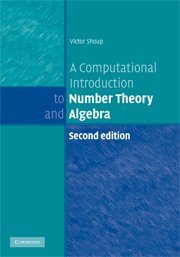Book contents
- Frontmatter
- Contents
- Preface
- Preliminaries
- 1 Basic properties of the integers
- 2 Congruences
- 3 Computing with large integers
- 4 Euclid's algorithm
- 5 The distribution of primes
- 6 Abelian groups
- 7 Rings
- 8 Finite and discrete probability distributions
- 9 Probabilistic algorithms
- 10 Probabilistic primality testing
- 11 Finding generators and discrete logarithms in ℤ*p
- 12 Quadratic reciprocity and computing modular square roots
- 13 Modules and vector spaces
- 14 Matrices
- 15 Subexponential-time discrete logarithms and factoring
- 16 More rings
- 17 Polynomial arithmetic and applications
- 18 Linearly generated sequences and applications
- 19 Finite fields
- 20 Algorithms for finite fields
- 21 Deterministic primality testing
- Appendix: Some useful facts
- Bibliography
- Index of notation
- Index
2 - Congruences
Published online by Cambridge University Press: 05 February 2015
- Frontmatter
- Contents
- Preface
- Preliminaries
- 1 Basic properties of the integers
- 2 Congruences
- 3 Computing with large integers
- 4 Euclid's algorithm
- 5 The distribution of primes
- 6 Abelian groups
- 7 Rings
- 8 Finite and discrete probability distributions
- 9 Probabilistic algorithms
- 10 Probabilistic primality testing
- 11 Finding generators and discrete logarithms in ℤ*p
- 12 Quadratic reciprocity and computing modular square roots
- 13 Modules and vector spaces
- 14 Matrices
- 15 Subexponential-time discrete logarithms and factoring
- 16 More rings
- 17 Polynomial arithmetic and applications
- 18 Linearly generated sequences and applications
- 19 Finite fields
- 20 Algorithms for finite fields
- 21 Deterministic primality testing
- Appendix: Some useful facts
- Bibliography
- Index of notation
- Index
Summary
This chapter introduces the basic properties of congruences modulo n, along with the related notion of residue classes modulo n. Other items discussed include the Chinese remainder theorem, Euler's phi function, Euler's theorem, Fermat's little theorem, quadratic residues, and finally, summations over divisors.
Equivalence relations
Before discussing congruences, we review the definition and basic properties of equivalence relations.
Let S be a set. A binary relation ∼ on S is called an equivalence relation if it is
reflexive:a ∼ a for all a ∈ S,
symmetric:a ∼ b implies b ∼ a for all a, b ∈ S, and
transitive:a ∼ b and b ∼ c implies a ∼ c for all a, b, c ∈ S.
If ∼ is an equivalence relation on S, then for a ∈ S one defines its equivalence class as the set {x ∈ S : x ∼ a}.
Theorem 2.1. Let ∼ be an equivalence relation on a set S, and for a ∈ S, let [a] denote its equivalence class. Then for all a, b ∈ S, we have:
(i) a ∈ [a];
(ii) a ∈ [b] implies [a] = [b].
Proof. (i) follows immediately from reflexivity. For (ii), suppose a ∈ [b], so that a ∼ b by definition. We want to show that [a] = [b]. To this end, consider any x ∈ S.
- Type
- Chapter
- Information
- Publisher: Cambridge University PressPrint publication year: 2008
- 1
- Cited by



